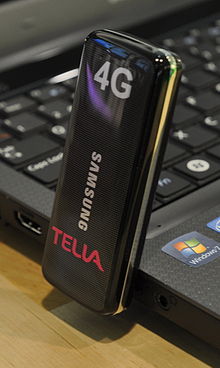
Overview Telia-branded Samsung LTE modem
A 4G system is expected to provide a comprehensive and secure all-IP based solution where facilities such as IP telephony, ultra-broadband Internet access, gaming services, and streamed multimedia may be provided to users.
This article uses 4G to refer to IMT-Advanced (International Mobile Telecommunications Advanced), as defined by ITU-R..
An IMT-Advanced cellular system must have target peak data rates of up to approximately 100 Mbit/s for high mobility such as mobile access and up to approximately 1 Gbit/s for low mobility such as nomadic/local wireless access, according to the ITU requirements. Scalable bandwidths up to at least 40 MHz should be provided.
In all suggestions for 4G, the CDMA spread spectrum radio technology used in 3G systems and IS-95 is abandoned and replaced by frequency-domain equalization schemes, for example multi-carrier transmission such as OFDMA. This is combined with MIMO (i.e., multiple antennas(Multiple In Multiple Out)), dynamic channel allocation and channel-dependent scheduling.
Predecessors of 4G
First-release LTE
Telia-branded Samsung LTE modem
The pre-4G technology 3GPP Long Term Evolution (LTE) is often branded "4G", but the first LTE release does not fully comply with the IMT-Advanced requirements. LTE has a theoretical net bit rate capacity of up to 100 Mbit/s in the downlink and 50 Mbit/s in the uplink if a 20 MHz channel is used — and more if Multiple-input multiple-output (MIMO), i.e. antenna arrays, are used.
The world's first publicly available LTE-service was opened in the two Scandinavian capitals Stockholm (Ericsson system) and Oslo (a Huawei system) on the 14 December 2009, and branded 4G. The user terminals were manufactured by Samsung [2] The two largest major mobile carriers in the United States and several worldwide carriers have announced plans to convert their networks to LTE beginning in 2011.
The physical radio interface was at an early stage named High Speed OFDM Packet Access (HSOPA), now named Evolved UMTS Terrestrial Radio Access (E-UTRA).
LTE Advanced (Long-term-evolution Advanced) is a candidate for IMT-Advanced standard, formally submitted by the 3GPP organization to ITU-T in the fall 2009, and expected to be released in 2012. The target of 3GPP LTE Advanced is to reach and surpass the ITU requirements. LTE Advanced should be compatible with first release LTE equipment, and should share frequency bands with first release LTE.
WiMAX and Mobile WiMAX
The Mobile WiMAX (IEEE 802.16e-2005) mobile wireless broadband access (MWBA) standard is sometimes branded 4G, and offers peak data rates of 128 Mbit/s downlink and 56 Mbit/s uplink over 20 MHz wide channels[citation needed]. The IEEE 802.16m evolution of 802.16e is under development, with the objective to fulfill the IMT-Advanced criteria of 1 Gbit/s for stationary reception and 100 Mbit/s for mobile reception. The world's first commercial mobile WiMAX service was opened by KT in Seoul, South Korea on 30 June 2006.
Sprint Nextel has begun using WiMAX, as of September 29, 2008 branded as a "4G" network.
UMB (formerly EV-DO Rev. C)
Main article: Ultra Mobile Broadband
UMB (Ultra Mobile Broadband) was the brand name for a discontinued 4G project within the 3GPP2 standardization group to improve the CDMA2000 mobile phone standard for next generation applications and requirements. In November 2008, Qualcomm, UMB's lead sponsor, announced it was ending development of the technology, favouring LTE instead. The objective was to achieve data speeds over 275 Mbit/s downstream and over 75 Mbit/s upstream.
4G features
The 4G system was originally envisioned by the Defense Advanced Research Projects Agency (DARPA). The DARPA selected the distributed architecture, end-to-end Internet protocol (IP), and believed at an early stage in peer-to-peer networking in which every mobile device would be both a transceiver and a router for other devices in the network eliminating the spoke-and-hub weakness of 2G and 3G cellular systems.[16] However, the first LTE USB dongles do not support any other radio interface. Although legacy systems are in place to adopt existing users, the infrastructure for 4G will be only packet-based (all-IP). Some proposals suggest having an open Internet platform. At an early stage, technologies considered to be 4G were: Flash-OFDM, the 802.16e mobile version of WiMax (also known as WiBro in South Korea), HC-SDMA (see iBurst), and LTE.



No comments:
Post a Comment